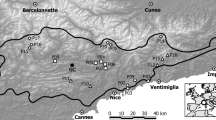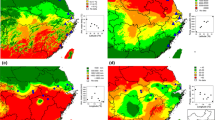Abstract
Populations of the common wild rice of AsiaO. rufipogon Griff. (=Oryza perennis Moench) were studied with regard to interrelations between life-history traits and habitat conditions. They showed a perennial-annual continuum and differed in reproductive allocation and many other traits. Perennial populations were found in deep swamps, while annual populations were in shallower, temporary swamps which were parched in the dry season. The perennial and annual types tended to be in association with other perennial and annual plants, respectively, suggesting their niche differentiation. Intermediate perennial-annual populations were in communities with a high species diversity. In one population, plants growing on the periphery of the swamp were of annual and those in deeper center were of perennial type. Another population seemed to be differentiated into an annual and an intermediate type in accordance with different degrees of habitat disturbance. The small genetic distances found between the sub-populations suggested their differentiation within a gene pool.
Similar content being viewed by others
References
Abrahamson, W. G., Gadgil, M., 1973: Growth form and reproductive effort in goldenrods (Solidago, Compositae). — Amer. Nat.107, 651–661.
Allard, R. W., Miller, R. D., Kahler, A. L., 1978: The relationship between degree of environmental heterogeneity and genetic polymorphism. — InFreysen, A. H. J., Woldendrop, J. W., (Eds.): Structure and Functioning of Plant Populations, pp. 49–73. — Amsterdam: North-Holland Publ.
Baker, H. G., 1970: Taxonomy and the biological species concept in cultivated plants. — InFrankel, O. H., Bennet, E., (Eds.): Genetic Resources in Plants, pp. 49–68. — Oxford: Blackwell.
Chu, Y. E., Morishima, H., Oka, H. I., 1969: Reproductive barriers distributed in cultivated rice species and their wild relatives. — Japan. J. Genetics44, 207–223.
—, 1970a: The genetic basis of crossing barriers betweenOryza perennis subsp.barthii and its related taxa. — Evolution24, 135–144.
—, 1970b: Introgression across isolating barriers in wild and cultivatedOryza species. — Evolution24, 344–355.
Clayton, W. D., 1968: Studies inGramineae, XVII. West African wild rice. — Kew Bulletin21, 485–488.
Gadgil, M., Solbrig, O. T., 1972: The concept ofr- andK-selection: Evidence from wild flowers and some theoretical considerations. — Amer. Nat.106, 14–31.
Jain, S. K., Bradshaw, A. D., 1966: Evolutionary divergence among adjacent plant populations, I. The evidence and its theoretical analysis. — Heredity21, 407–441.
Law, R., Bradshaw, A. D., Putwain, P. O., 1977: Life history variation inPoa annua. — Evolution31, 233–246.
Linhart, Y. B., 1974: Intrapopulational differentiation in annual plants,I.Veronica peregrina L. raised under non-competitive conditions. — Evolution28, 232–243.
McNaughton, S. J., 1975:r andK-selection inTypha. — Amer. Nat.109, 251–261.
Morishima, H., 1969: Phenetic similarity and phylogenetic relationships among strains ofOryza perennis, estimated by methods of numerical taxonomy. — Evolution23, 429–443.
—, 1961: Directions of differentiation in populations of wild rice,Oryza perennis andO. sativa f.spontanea. — Evolution15, 326–339.
—, 1970: A survey of genetic variations in the populations of wildOryza species and their cultivated relatives. — Japan. J. Genetics45, 371–385.
-Sano, Y., Oka, H. I., 1980: Observations on wild and cultivated rices and companion weeds in the hilly areas of Nepal, India and Thailand. — Report from Nat. Inst. Genetics, Misima, Japan.
Nei, M., 1975: Molecular Population Genetics and Evolution. — Amsterdam: North-Holland Publ.
Ng, N. Q., Chang, T. T., Williams, J. T., Hawkes, J. G., 1981: Morphological studies of Asian rice and its related wild species and the recognition of a new Australian taxon. — Biol. J. Linn. Soc.16, 303–313.
Numata, M., 1982: A methodology for the study of weed vegetation. — InHolzner, W., Numata, M., (Eds.): Biology and Ecology of Weeds, pp. 21–34. Hague: Junk.
Oka, H. I., 1976: Mortality and adaptive mechanisms ofOryza perennis strains. — Evolution30, 380–392.
—, 1967: Variations in the breeding systems of a wild rice,Oryza perennis. — Evolution21, 249–258.
-Morishima, H., Sano, Y., Koizumi, T., 1978: Observations of rice species and accompanying savanna plants on the southern fringe of Sahara desert. — Report from Nat. Inst. Genetics, Misima, Japan.
—, 1981: Differentiation ofOryza perennis populations in adaptive strategy. — InAltukhov, Y. P., (Ed.): Problems in General Genetics (Proc. XIV ICG), II(1), 65–85. — Moscow: MIR Publ.
Pai, C., Endo, T., Oka, H. I., 1973: Genic analysis for peroxidase isozymes and their organ specificity inOryza perennis andO. sativa. — Can. J. Genet. Cytol.15, 845–853.
—, 1975: Genic analysis for acid phosphatase isozymes inOryza perennis andO. sativa. — Can. J. Genet. Cytol.17, 637–650.
Roughgarden, J., 1971: Density-dependent natural selection. — Ecology52, 453–468.
Sano, Y., Morishima, H., Oka, H. I., 1980: Intermediate perennial-annual populations ofOryza perennis found in Thailand and their evolutionary significance. — Bot. Mag. Tokyo193, 291–305.
—, 1982: Variations in resource allocation and adaptive strategy of a wild rice,Oryza perennis Moench. — Bot. Gaz.143, 518–523.
Second, G., Trouslot, P., 1980: Electrophorèse d'enzymes de riz. — Travaux et Documents de l'ORSTOM, N° 120. — Paris, ORSTOM.
Sneath, P. H. A., Sokal, R. R., 1973: Numerical Taxonomy. — San Francisco: Freeman.
Sokal, R. R., Rohlf, F. J., 1969: Biometry. — San Francisco: Freeman.
Stebbins, G. L., 1958: Longevity, habitat and release of genetic variability in the higher plants. — Cold Spring Harbor Symp. Quant. Biol.23, 365–378.
Tateoka, T., 1964: Taxonomic studies of the genusOryza. — In I.R.R.I. (Ed.): Rice Genetics and Cytogenetics, pp. 15–23. — Amsterdam: Elsevier.
Werner, P. A., Platt, W. J., 1976: Ecological relationships of co-occurring goldenrods. — Amer. Nat.110, 959–971.
Whyte, R. O., 1972: The gramineae, wild and cultivated of monsoonal and equatorial Asia, I. Southeast Asia. — Asian Perspectives15, 127–151.
Wright, S., 1965: The interpretation of population structure by F-statistics with special regard to systems of mating. — Evolution19, 395–420.
Author information
Authors and Affiliations
Additional information
Contribution from National Institute of Genetics, Japan, No. 1415.
Rights and permissions
About this article
Cite this article
Morishima, H., Sano, Y. & Oka, H.I. Differentiation of perennial and annual types due to habitat conditions in the wild riceOryza perennis . Pl Syst Evol 144, 119–135 (1984). https://doi.org/10.1007/BF00986670
Received:
Issue Date:
DOI: https://doi.org/10.1007/BF00986670




